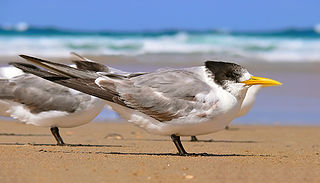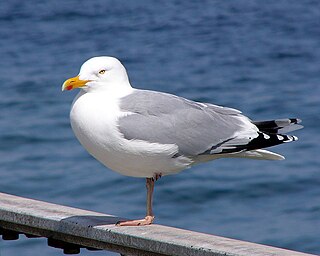
Terns are seabirds in the family Laridae that have a worldwide distribution and are normally found near the sea, rivers, or wetlands. Terns are treated as a subgroup of the family Laridae which includes gulls and skimmers and consists of eleven genera. They are slender, lightly built birds with long, forked tails, narrow wings, long bills, and relatively short legs. Most species are pale grey above and white below, with a contrasting black cap to the head, but the marsh terns, the Inca tern, and some noddies have dark plumage for at least part of the year. The sexes are identical in appearance, but young birds are readily distinguishable from adults. Terns have a non-breeding plumage, which usually involves a white forehead and much-reduced black cap.

Laridae is a family of seabirds in the order Charadriiformes that includes the gulls, terns, noddies, skimmers, and kittiwakes. It includes around 100 species arranged into 22 genera. They are an adaptable group of mostly aerial birds found worldwide.

The white tern or common white tern is a small seabird found across the tropical oceans of the world. It is sometimes known as the fairy tern, although this name is potentially confusing as it is also the common name of Sternula nereis. Other names for the species include angel tern and white noddy in English, and manu-o-Kū in Hawaiian. The little white tern, previously considered a subspecies of the white tern, is now recognised as a separate species.

The terrestrial fauna of the Cocos (Keeling) Islands is unsurprisingly depauperate, because of the small land area of the islands, their lack of diverse habitats, and their isolation from large land-masses. However, the fauna dependent on marine resources is much richer.

The little white tern is a small seabird found in French Polynesia and the Republic of Kiribati. This species was previously considered a subspecies of the white tern, but is now recognised as a separate species.
The little white tern is a small seabird found in Pacific Ocean. This species was previously considered as the white tern, but is now recognised as a separate species.








